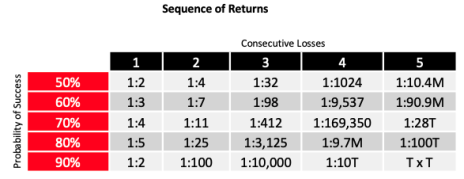Profits, profits, profits, that’s all most traders, particularly newbies, think about when placing a trade. But, when taking a statistical or quantitative approach to the market, the most important factor is risk management. And proper risk management starts with a proper position-sizing plan.
So rather than looking at ourselves as traders or investors, I would argue that we should be looking at ourselves as risk managers. Because again, if we understand the law of large numbers we know that the probabilities we choose will define our success.
But in order for the law of large numbers to work, we must have a large enough sample size or, in our case, number of trades.
[text_ad use_post='261460']
For instance, if we take a position that has an 80% probability of success we should expect to see a win ratio of roughly 80%. But the journey to get to that percentage should never be considered straight forward, especially in the beginning. Basically, just because you place 10 trades, eight of those trades are not guaranteed to be winning trades. In the world of statistics, we call this sequence risk, or sequencing risk.
Coin Toss Example
Think about a coin toss.
A coin has a 50% chance, or probability, of landing on heads or tails.
Therefore, according to the Law of Large Numbers, the number of heads in a large number of coin flips should be 50%, which is known as our expected value. Basically, as our number of trades increase over time our win ratio should fall increasingly closer to our expected value—again, 50%.
But we must understand that when we follow a quantitative approach there are several obstacles in our way.
When flipping a coin 10 times the variance of the coin landing on heads has an average range of three heads to seven heads. As we increase the number of observations the range tightens until eventually the overall probability of success stands at approximately 50%.
But, early on, due to variance we will experience bouts of sequencing risk.
So just because our expected value is 50% it doesn’t mean that for every 10 flips we are going to fall right at 50%, or five heads and five tails. In the world of quantitative trading, we call this sequencing risk. Sequencing risk simply means that we could have numbers that vary from zero heads to 10 heads for every 10 flips. We call these statistical outliers, or tail risk, and they should be expected from time to time.
But again, the Law of Large Numbers always falls around the expected outcome as the number of observations (trades) increases.
It’s an incredibly easy concept to understand, yet most traders simply don’t allow the Law of Large Numbers to work in their favor. Lack of patience is typically the reason.
In short, knowing we have a probability of success greater than 80% on the trade, our win ratio, as our number of trades increases, should fall around 80%.
Of course, as I stated before much of your success relies on how disciplined you are as a risk manager, achieved through consistent and strict position-size guidelines.
Position-Sizing Guidelines
Position sizing is simply the percentage of overall capital allocation dedicated to a trade.
For example, if an investor has an account size of $100,000 and decides to place a trade that requires $5,000 in capital, the position size is 5% of the portfolio’s overall capital.
Position sizing plays an ENORMOUS factor in constructing a portfolio, while simultaneously acting as a major source of managing risk.
I typically risk between 0.5% to 6% per position. But everyone has a different level of risk tolerance, therefore position size will vary from one individual to the next. However, you MUST incorporate strict guidelines to position size if you wish to have any chance of being successful over the long term. Again, we must allow the law of large numbers to work.
Regardless of the amount of capital you are trading, focus on the percentages. Oftentimes, those with smaller accounts focus more on the amount of money they can make on each trade, rather than the percentages. Focus on the percentages!
Sequencing Returns
As I mentioned earlier, sequencing risk is a major player in the world of statistically-based, high-probability options strategies. Which is why position size is so important.
Position size allows us to calculate how many consecutive losses would need to occur to lose a specific amount of capital in our overall trading account. Sequence of returns is the inherent risk that a trader could experience several losses in a row. Knowing that the sequence of returns is a math-based reality, our chosen position size helps to lessen the impact of a string of potential losing trades.
The following table demonstrates the statistics of experiencing consecutive losses based on your chosen probability of success at the time of entering trade. As you will quickly notice, as the probability of success increases, the likelihood of consecutive losses diminishes exponentially.
So, for example, if I were to consistently use a risk-defined options strategy like an iron condor with a delta of 0.20 or a probability of success of 80%, there is a 4% chance of losing two trades in a row and 0.03% chance of losing five trades in a row. So, knowing this info, we have the ability to plan accordingly by choosing a realistic position size based on the probability of success of our trade.
I can’t emphasize enough just how important position size is when trading, especially when using a high-probability approach. We ALL should think of ourselves as risk managers first and traders second. If you are able to follow this mindset, you will have a much better chance of being successful over the long term.
Remember, statistically based trading is simply a game of math. We are trading high-probability strategies here, so we know we have an advantage over the long term, but we must have a sound understanding of how to manage sequence risk accordingly. Position size is probably the most important factor, so don’t ignore it.
As always, if you have any questions, please feel free to email me or post your question in the comments section below.

